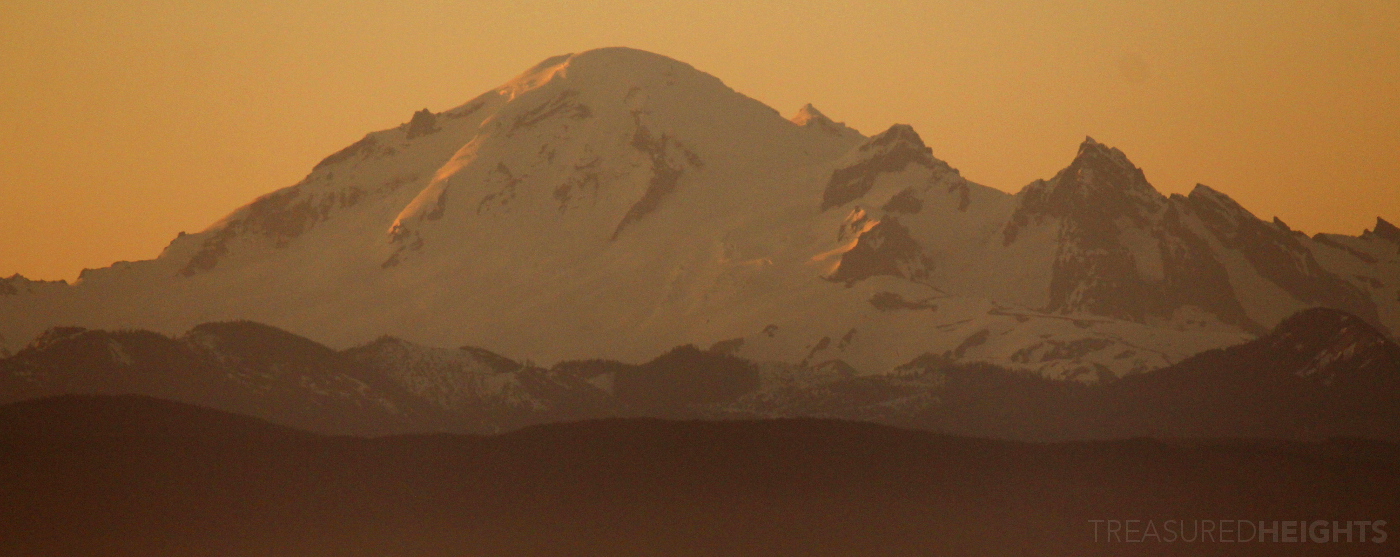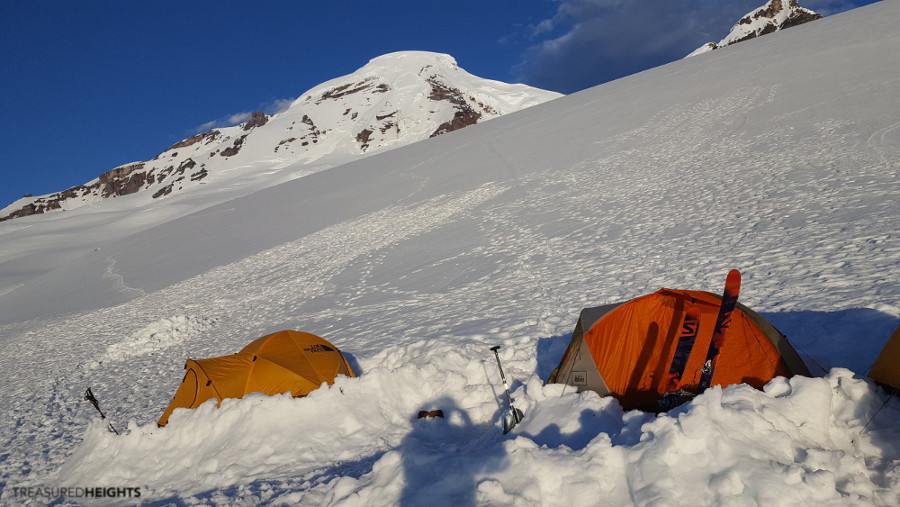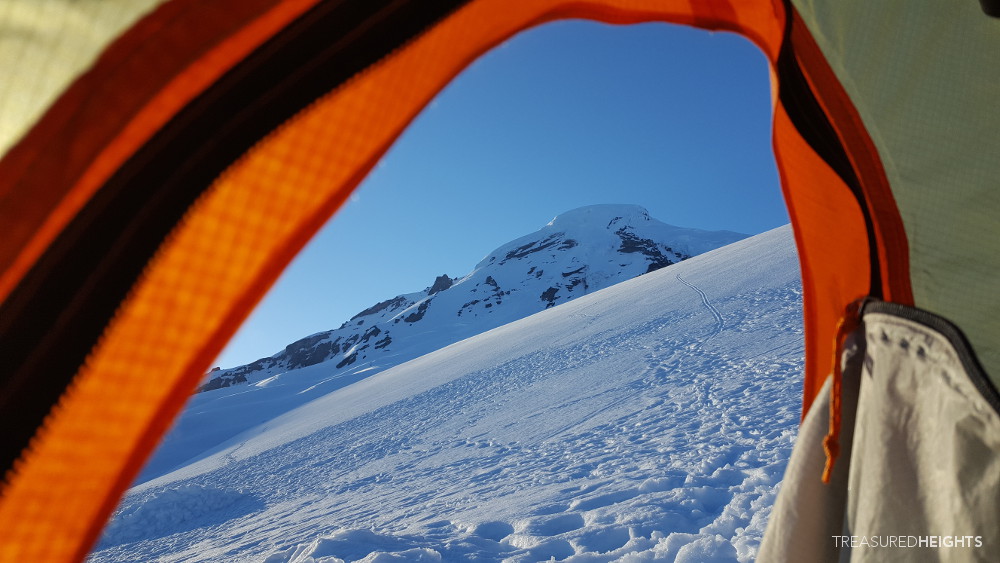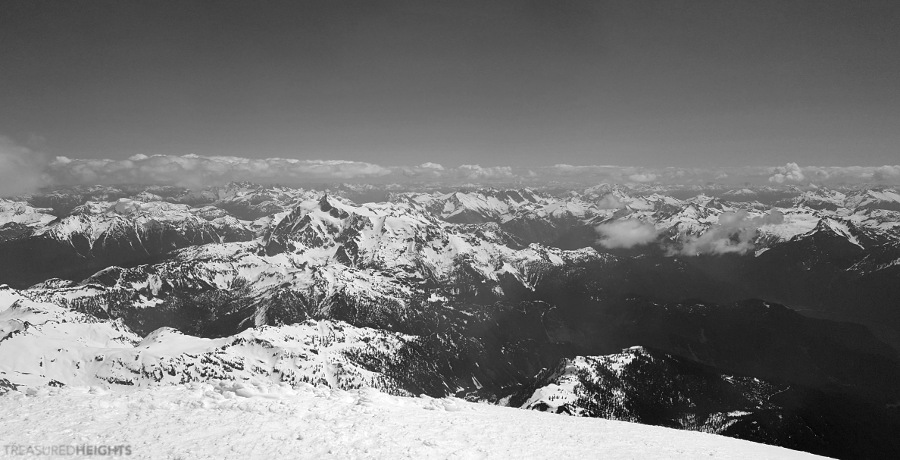The setting sun struck me as I rounded the top of the glacier. With a hop over the moat I was standing atop the spectacular Heliotrope Ridge gazing at a Himalayan-like scene. Glaciers tumbled down sharp pyramids on this island above the surrounding peaks. This perfect moment naturally marked 20 years of skimountaineering for me.
Mt. Lincoln stabbed the sky like a Himalayan giant as the Thunder Glacier cascaded down the valley before me. While it was technically a few months beyond my 20 year anniversary of backcountry skiing by a few months, that didn’t matter. The sun gleamed off of a sea of peaks, creamy spring corn snow waited for turns, and I had an anticipation of a fun descent to camp. In my mind it was like the planets had aligned and this was the National Geographic image I’d already known as a child. Despite the well-earned reputation of the Cascade Range as a place of wicked weather and hostile wet-cold, this range has handed me some of the most beautiful and friendly moments any range has given. Of all of the Cascade’s famous volcanos Baker has stood out to me as the most friendly big mountain for backcountry skiers in the United States, and I had a feeling this was going to be a perfect trip.
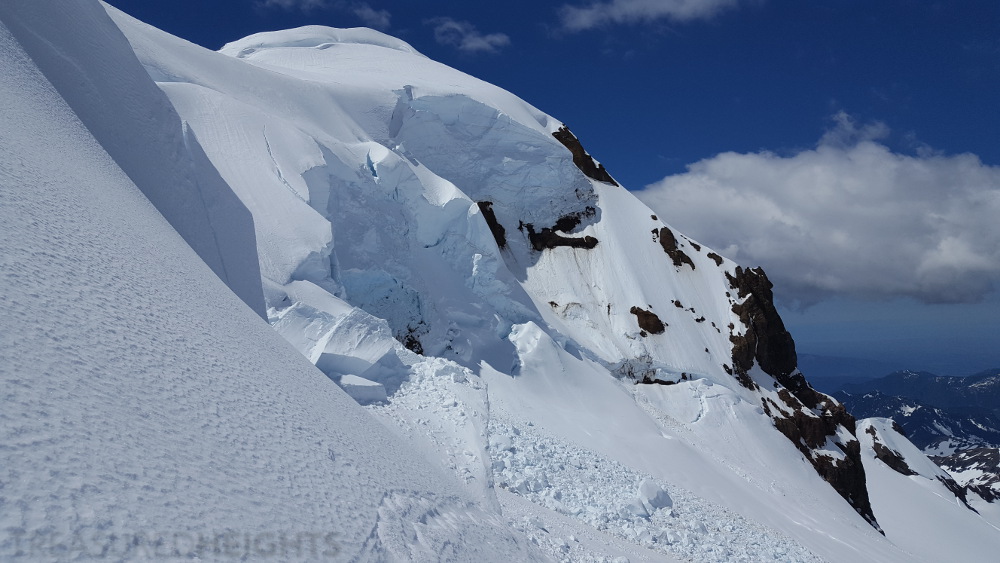
The Snow
Huge glaciers drape off of all sides of Baker and it stands prominently above all other peaks only 35 miles from the ocean. It has the second highest concentration of glaciers in the US Cascade Range (Rainier is #1) and it towers a mile higher than surrounding peaks. The prominence and position are what helps it scour moisture from the clouds that flow from the nearby Pacific Ocean. The US Geological Survey ranks this volcano’s threat potential as “Very High”, and significant amounts of steam rise from its crater. What makes this stratovolcano unique in the world is it’s snowfall. The massif gets over 800” of snow annually on most years, with 1000+ inch (24.5+ meters) snowfalls on certain seasons. This quantity is measured from the ski area which sits quite a bit lower than the summit, so the peak proper gets even more snow. Mount Baker has been attractive to skiers since 1926 when roads were constructed to Heather Meadows.
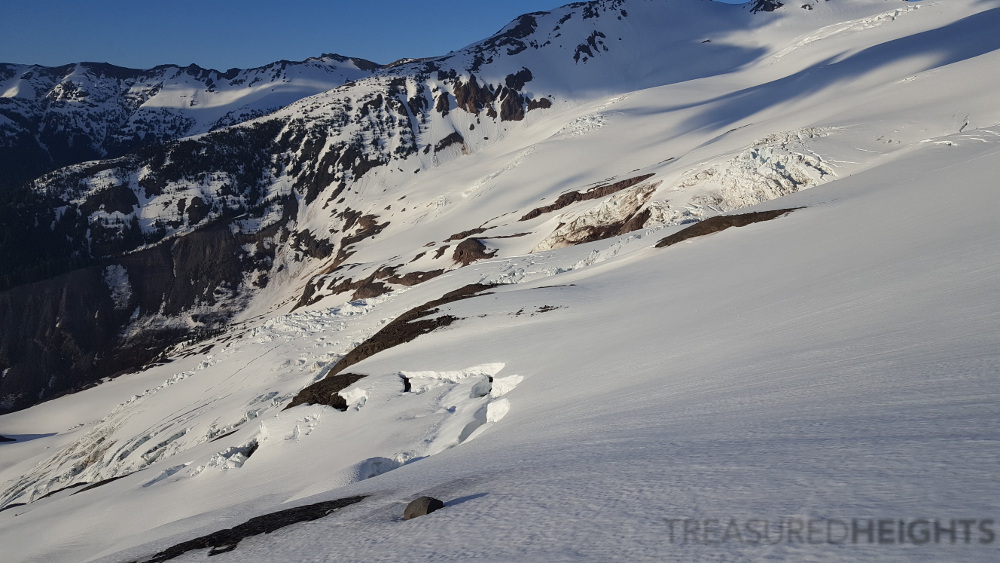
The Magic Northwest:
It began with driving on the narrow, aging and deserted single lane road through lush forest at night into the unknown. After passing a few cars parked on the side of the road I suddenly found snow in my path. It’s May 24th and we have snow down to 2800’. T’was a good year here I guess.
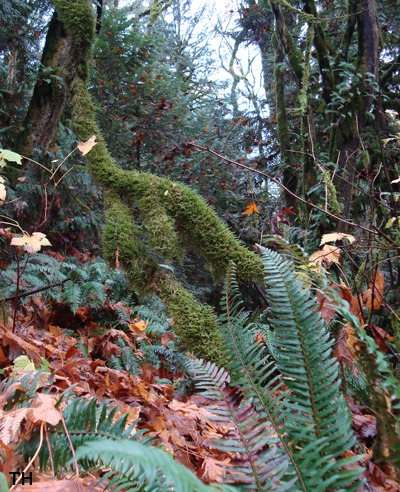
Coming from Colorado where the average starting elevation is above 10,000 feet it felt surreal to be at such “low” elevations and running into snow. After crossing a stream and almost sliding off the road on dense Northwestern snow it became clear that this snow was going to be harder to drive through than airy, loose Rocky Mountain late season snow. This was as high as I was going to get with the vehicle.
After a night in the car it was a straightforward skin up the road to the summer trailhead. The Heliotrope Ridge Trail is a popular summer hike that gives hikers a close view of Baker and the Heliotrope and Coleman Glacier. In the winter and spring the trail has only a fraction of the traffic, one of the reasons I love skiing.
Today the trail was deserted and at times it was difficult to know where it went as it crossed ravines and made steep switchbacks. The air smelled warm and heavy with pine. Eventually I just skinned up through the woods at the point when following the trail took more effort than self orientation. Reaching treeline is always a treat on any mountain. On Baker it was especially exciting as views unfolded of crevassed Coleman Glacier and spread of surrounding peaks.
I set up camp along with a guided group on a spot with available rocks (for use as anchors for the tent) and a great view of the Coleman Glacier. With plenty of available daylight left I was happy to leave the heavy gear behind and do a day trip up to the ridge to catch the sunset.
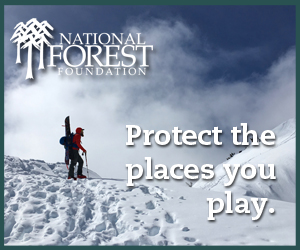 While sunrises are beautiful, most of the time in this type of skiing it’s very cold in the morning and you are still on your way up, in a rush to get onto the line before the sun makes it dangerous. There is not proper calm to enjoy the sunrise. Back in Colorado at sunset in the late season the snow is often totally rotten, wet and prone to avalanches, so you cannot enjoy it then either. Here in the Northwest the snow is so dense that on this day only the top 2” became soft after a full day of sun. I reached the top of the Heliotrope ridge at the start of sunset and relaxed for about an hour on warm dark volcanic rock. It was a rare treat followed by a perfect run down creamy snow to camp. The guided group of about 12 had arrived by this time.
While sunrises are beautiful, most of the time in this type of skiing it’s very cold in the morning and you are still on your way up, in a rush to get onto the line before the sun makes it dangerous. There is not proper calm to enjoy the sunrise. Back in Colorado at sunset in the late season the snow is often totally rotten, wet and prone to avalanches, so you cannot enjoy it then either. Here in the Northwest the snow is so dense that on this day only the top 2” became soft after a full day of sun. I reached the top of the Heliotrope ridge at the start of sunset and relaxed for about an hour on warm dark volcanic rock. It was a rare treat followed by a perfect run down creamy snow to camp. The guided group of about 12 had arrived by this time.
It is inspiring observing beginners get their first big mountain experience. Most of the group had come from the Midwest or U.S. South, and I could only begin to imagine how wonderful their experience was in taking in the view of their first glacier, their first winter camping and first significant summit. Unlike many advanced skiers these days who objectify summits and experiences, I could feel the joy and wonder in this group.
DAY 2: I gazed from the tent onto Baker’s summit as i cooked breakfast. After a half log of summer sausage and oatmeal I started my day skinning up frozen textured sharp snow. The group had already left, an advantage of skimountaineering vs. mountaineering is more luxury with time. You can reach summit later in the day because skiing down quickly removes you from the warming slopes.
Along the edges of the route I observed 40’ wide crevasses and the spectacular steep Colfax Peak and ridge. I could see the guided group above me, looking like a line of fleas on blue shaded snow. After a full season of skiing I felt fit and challenged myself to catch up to them despite having started hours after.
Baker’s incredible steep Northwest face loomed above to the left. It looked icy and heinous at this time of the morning, that is a great ski in the right conditions. Lou Dawson has a recent account of skiing on this face.

Reaching the col at 9000’ brings a view south over the many fascinating glaciated peaks to the south, and a look up at the final 1800’ slope to what looks like the summit. I was catching up to the guided group, but decided to give up on the goal to hang out and let the sun warm up the icy surface, skiing ice is no fun.
Heading onto the ridge above the col you stand between the shaded steel-hard ice face on the left and the bright Deming Glacier on your right. Under these conditions later in the day it would be possible to skin all the way up the final face, however this early in the day it was better to switch to crampons and boot up the face. The top of the Deming Glacier forms the steepest part of the easiest way up Baker – equivalent to a double black diamond ski run, except that a fall here can land one into a horizontal crevice below. Many have fallen here in icy conditions so it is important to arrive at the right time of day. Booting up the Deming glacier I felt that the surface was still not ready, with plenty of hard icy ridges and chickenheads.
Rounding the top of the “summit” it became clear it was not the summit, before me was the flat expansive plain with clouds whipping across, obscuring the true summit beyond. Mentally I switched into cross-country ski mode and droned on through the flat as the wind blasted ice balls and fog at my face. The weather changed by the minute, and later standing alone on the summit the rest of the North Cascades looked small. Once again it’s an airliner’s view, with the tallest peak being nearby Mt. Shuksan – perhaps the most photographed mountain in the US.
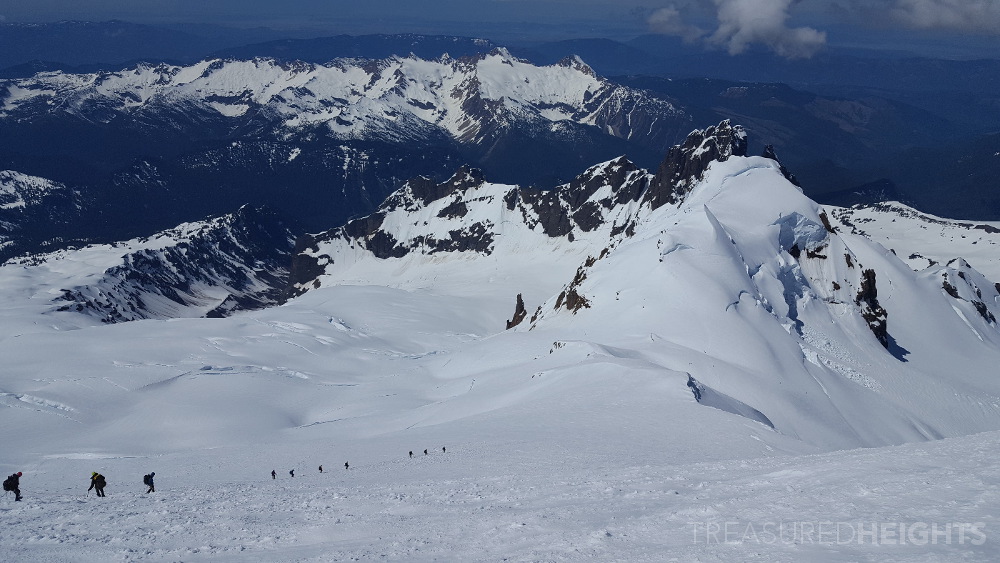
It was exciting prepping for the descent above the Deming face. I launched downward out of the wind to the steepest part of the run. I cautiously carved, and after 200’ I was slashing soft chickenheads with the metal edges. I passed the guided group, and some skiers coming up.
The skiing was comfortable, moderate and just plain fun with great aesthetics the whole way. While some complain the lower part of the route is not steep enough, under firm conditions it’s a nice glide-ride past beautiful glaciated terrain. Nothing boring here. If one wants to add some more spice, it’s easy to add Colfax Peak in. Other lines off the Colfax ridge offer a full range of steepness to build the perfect day, make it a 10,000 vertical foot day if you like!
Part of what makes Baker the perfect first big mountain for a rising backcountry skier is the ability to customize your experience. The layout offers an easy way down along with plenty of add-ons. The “low” elevation of the peak at 10k’ makes altitude sickness less of an issue than the Colorado 14ers or Rainier. If you are well acclimatized you will feel sharp and ready to rock from top to bottom.
All this being said Baker still has a long list of fatalities. While most are caused by human error, some are caused by “wildcards” like a falling serac, or avalanche. Before attempting a mountain like Baker it’s recommend to have a solid list of experience on other peaks using mountaineering skills and equipment. In ideal weather people can get away with being clumsy and inexperienced, however on Baker the weather can change in minutes. Even with ideal weather in the forecast for this trip there were moments of blue sky suddenly followed by clouds rushing over the slope at 30 mph and soon after it was raining ice balls with no visibility. These conditions are not the time to be learning how to use crampons, or orientation skills. The moderate temperatures here mean precipitation can be in the form of wet snow that sticks to and soaks your layers, leading to hypothermia.
Day Tripping:
I chose to camp because of the beautiful experience of waking up on the flanks of the peak, however it is possible to ski from the summit of Baker in a day. This is a 7000-8000’ day and should only be done if in good shape. For a more “normal” backcountry day you can ski any part of the Heliotrope Ridge and funnel back down to the trail or jeep road that traverses in the forest below. In many cases day trips are all you can hope for as the summit can stay cloudy with very “un-fun” icy slopes and wicked weather. At the same time the lower slopes of the mountain can be sunny and nice. This effect of halving opposing conditions on the same mountain at the same time is typical of peaks with big vertical.
Treasured heights?
In 1897 President Cleveland declared 8 million acres including Mt. Baker as protected from logging, farming and mining, however locals and industry opposed this and had the rules changed to allow extraction practices. In 1908 the area became Washington National Forest. Mt. Baker is protected as National Forest, but oddly is not included in the North Cascades National Park right next to it. The peak is split into the Mt. Baker Wilderness and the Mt. Baker National Recreation Area. Unlike Rainier, snowmobiles are allowed on the lower south-east side of the mountain, expect noise pollution on certain days.
The Lummi and Nooksack tribes named Baker “Kulshan” which means White Sentinel Crater (Puncture Wound) and White Mountain. The mountain second behind Mt. St. Helens as the most active in the Northwest. It last erupted in 1891 and sent a lahar (mud/ice slide) more than 6 miles down the valley. It is entirely possible that we will see another large eruption in the next 100 years.
A Hot Summer Finish:
After skiing down to camp I took a nap in the hot tent. The guided group arrived an hour later and I packed up. The snow was wet cement below 5000’. This is particularly hard with a heavy pack filled with overnight gear. In the forest I skied narrow strips of icy snow. After that was a cruise down the road. In comparison to the steep ice of Borah in Idaho a few days before Baker was a gentle giant and a chill ski. The lower slopes were thick with humid hot summer air.
For any backcountry skier wishing to experience the Northwestern Volcanos I recommend Baker as a great first step. Go through a guided service for your first time on a glaciated peak to get a solid foundation of knowledge that you can carry with you as you continue to explore.
See articles about backcountry skiing around the country on this blog.
Follow Treasured Heights on Facebook or Instagram
About the Skiing States Project:
![]() See a weekly stream of photos from Treasured Heights from around the US on Facebook or Instagram.
See a weekly stream of photos from Treasured Heights from around the US on Facebook or Instagram.

